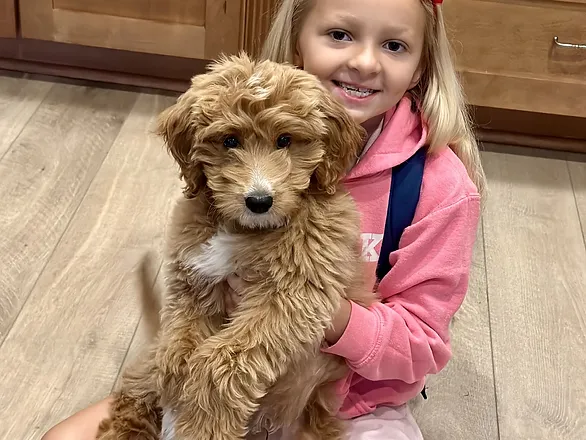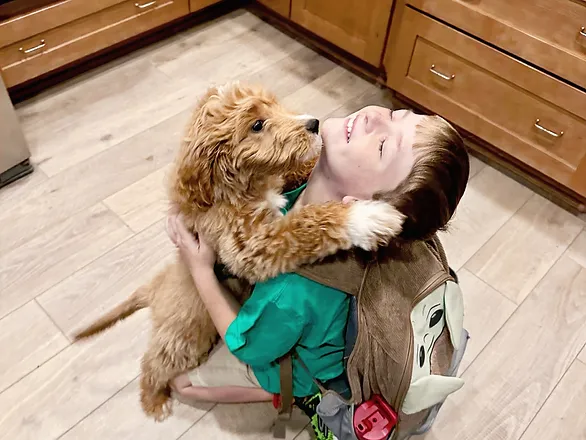This blog post focuses on age-appropriate pet responsibilities.

This site contains affiliate links, please view the disclosure for more information.
Teaching Your Children Age-Appropriate Pet Responsibilities
In October 2023, our household grew by four furry paws with the arrival of Waffles, our adorable Goldendoodle puppy! This was a landmark moment for us, marking our first adventure into pet parenthood. My husband and I had fond memories of growing up with dogs, but this was our first experience as dog ‘parents.’ And for our five children, ranging in age from 8 to 21, Waffles was their first ever pet. We were charting new territory together!
Today, I’m thrilled to share our journey and discuss a topic close to our hearts: guiding our children in learning pet responsibilities. Pets are more than just cuddly companions; they are wonderful teachers of responsibility, compassion, and love. The important question we faced was, how do we assign age-appropriate pet responsibilities to each of our kids? Let’s jump into this heartwarming story together. We’ll see how bringing a pet into the family is a fun and educational journey for kids, no matter how old they are.
Toddlers (Ages 1-3): Age-Appropriate Pet Responsibilities for the Little Helpers
Feeding Time
At this age, your toddler is probably more interested in playing with the pet food than actually feeding the pet. But that’s okay! It’s all about introducing them to the concept of feeding. You can let them help you pour food into the pet’s bowl. It’s a simple task, but it gives them a sense of involvement and teaches them the basics of pet care.
Gentle Play
Teaching toddlers to play gently with pets is important. Show them how to pet the dog or cat softly. It’s a great way for them to learn about being kind and gentle with other living beings.
Preschoolers (Ages 4-5): Growing Age-Appropriate Pet Responsibilities
Basic Grooming
Preschoolers can start learning about grooming. They can help with brushing the pet’s fur. Make it a fun activity by talking about why grooming is important for pets. It’s a great way for them to bond with their furry friend.
Simple Commands
Teaching your pet simple commands? Get your preschooler involved! They can learn to give commands like ‘sit’ or ‘stay’. It’s fun for the kids and the pet, and it teaches them about training and discipline.

Early Elementary (Ages 6–8): Stepping Up the Game
Feeding and Watering
By now, your child can take on more responsibility. They can feed the pet and make sure the water bowl is always full. It’s a good way to teach them about daily routines and the importance of regular meals for health.
Cleaning Up
Yes, it’s time to introduce them to cleaning up after the pet. Whether it’s cleaning the litter box or picking up after the dog in the yard, it teaches them that pet care isn’t always just fun and games; it’s a part of the commitment they’ve made.
Tweens (Ages 9-12): Responsible Young Pet Owners
Exercise and Play
Tweens can be responsible for walking the dog or playing with the pet to ensure it gets enough exercise. It’s a great way for them to stay active too and understand the importance of physical activity for their pet.
Health Care
You can start teaching them about pet health. They can help you schedule vet appointments and even remind you when it’s time for vaccinations or flea treatments. It’s a way to educate them about the health needs of pets.
Teens (Ages 13+): The Young Adults of Pet Care
Full Responsibility
Teens can handle most pet care responsibilities, from feeding and grooming to walking and even administering medication. It’s a great way for them to demonstrate maturity and their ability to handle more complex tasks.
Emergency Handling
Teach them about what to do in case of a pet emergency. They should know the basics of pet first aid and when to call the vet. This helps them develop critical thinking and problem-solving skills.

Building a Bond: Emotional Connections
Understanding Emotions
As our kids grow, it’s important for them to understand that pets have feelings too. Encourage your children to notice signs of happiness, stress, or fear in the pet. This helps build empathy and a deeper bond between them. You can have discussions about how certain actions make the pet feel, teaching them to respect and care for the pet’s emotional needs.
Respect for Space
Another key lesson is teaching kids to respect the pet’s space. Just like us, pets need their alone time. Explain to your child that sometimes the pet may not want to play or be cuddled. This respect for boundaries is an important part of their learning.
Responsibility Beyond the Home
Community Involvement
Involve older kids in community activities related to pets. This could be a visit to the animal shelter, volunteering for pet-related community services, or participating in local animal welfare events. It not only broadens their understanding of pet care but also instills a sense of community responsibility.
Learning About Wildlife
Pets aren’t just our domestic companions. Our world is filled with amazing wildlife. Teach your kids about different animals, their habitats, and how to responsibly interact with wildlife. This broadens their view and respect for all creatures.
Advanced Pet Care Skills
Training Skills
For more enthusiastic and older kids, diving into advanced pet training can be both challenging and rewarding. Let them learn and teach new tricks to the pet. This not only strengthens their bond with the pet but also develops patience and persistence.
Understanding Pet Nutrition
Nutrition is a vital aspect of pet care. Teach your teens about the importance of a balanced diet for pets, how to read pet food labels, and how to choose the right food. This is a valuable skill that contributes greatly to the pet’s overall health.
Safety and Emergency Preparedness
First Aid for Pets
As kids enter their teenage years, they can learn basic first aid for pets. Teach them about common pet injuries and how to respond in such situations. This knowledge is crucial and can be life-saving.
Disaster Preparedness
Include your kids in preparing a disaster plan that includes the pet. This could involve understanding what to do in case of emergencies like fires, floods, or earthquakes. Discuss and prepare a pet emergency kit together.
Financial Aspects of Pet Care
Understanding Costs
Introduce your teens to the financial aspect of pet care. Discuss the costs involved in keeping a pet healthy and happy, such as food, grooming, veterinary care, and insurance. This is a great way to teach them about budgeting and financial responsibility.
Earnings for Pet Expenses
For older teens, encourage them to take on small jobs like pet-sitting in the neighborhood. This not only helps them earn a bit of money but also teaches them the value of hard work and money, especially when it’s for someone they care about—their pet.

Final Thoughts on Age-Appropriate Pet Responsibilities
It’s been a whirlwind six weeks since Waffles, our lovable Goldendoodle, became a part of our family. Our days have been filled with giggles, new lessons, and lots of affection. Every new day is a fresh experience, helping both us and our kids learn important things about taking care of pets and being responsible.
As you go on your own adventure with age-appropriate pet responsibilities, think of each little step as a chance to grow. From the first time you help them eat to the patience needed during house training, it’s all about more than just looking after a pet. It’s about our families growing stronger together.
We’re really enjoying our first days with Waffles, and we hope you enjoy your time with your pet just as much. Take on the ups and downs of bringing a new pet home with open arms. Every part of this journey is an opportunity to teach something new and learn right beside your animal buddy.



